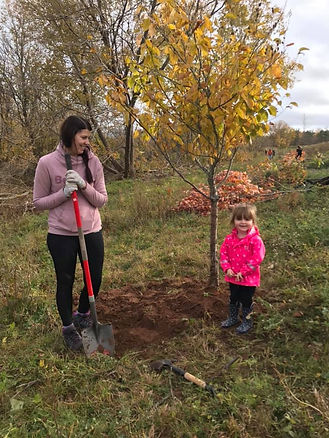Stabilized Fording Sites
Since crop and pasture lands often straddle watercourses, providing safe crossings for livestock and equipment with reduced potential for negative water quality effects is critical. Additionally, watering livestock at rivers is often the only practical option for agricultural producers. The KWRC has used stable fording sites as both watering locations for livestock as well as crossings for farm equipment. The approaches are properly aligned and hardened, and the stream bottom is stabilized with hard rock to prevent erosion and rutting. Since 1994 the KWRC has installed 85 stabilized fording sites in the watershed.

Kennebecasis Watershed Restoration Committee
Worth Wading Into
Tree Planting
The end goal of all bank stabilization efforts is the reestablishment of the natural riparian vegetative community. Not only does the riparian zone have innumerable biological roles in the aquatic community, it is nature's way of permanently stabilizing stream banks. Whenever possible, the first thing we do is plant native trees in the riparian zone. Most times, however, erosion is proceeding at such a rate, that our young trees don't have a chance. We must employ methods of bank stabilization that allow our planted trees to grow enough to take over the job.
By the end of 2017 the KWRC will have planted more than 255,000 trees along degraded riparian zones, restoring approximately 374,000m2 of valuable stream side habitat within the Kennebecasis Watershed.
Benefits of Tree Planting
1. Increased site biodiversity.
2. Stabilization of eroding stream banks through increase root mass.
3. Decrease in sediment and nutrient transfer to streams by root absorption.
4. Reduced run-off rates through increased site surface water retention.
5. Moderated stream temperatures provided by increased shade cover.
6. Increased fish cover and habitat.
7. Increased aquatic food source through falling organic debris.
8. Reduced carbon emissions as a result of reduction in bare topsoil and through uptake from vegetation.
9. Improved bird and pollinator habitats leading to better crop production.
10. Better site stability leading to easier land use planning.

These two restoration sites were completed in 2015 as part of our DeForest Reach Enhancement project along Trout Creek

Tree planting - Volunteers
Many of our tree planting initiatives would not be possible without the hard work and dedication of our local volunteers.
Interested in volunteering with us? Fill out our volunteer form!
Photos of some of our hardworking volunteers at our October 2020 tree planting event
